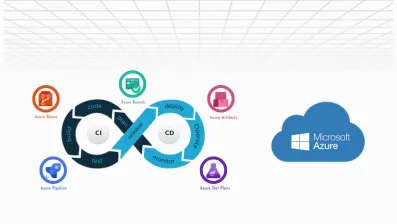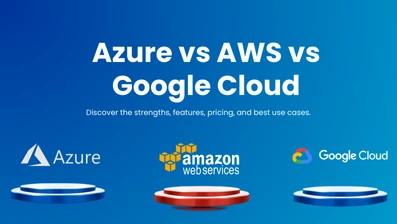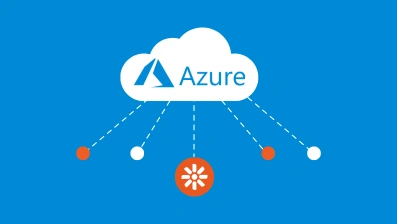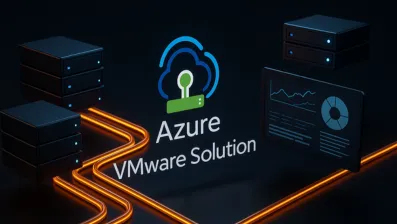In the dynamic world of cloud computing, security isn't just a feature—it's a necessity. Microsoft Azure, one of the leading cloud platforms, is trusted by enterprises around the globe for hosting everything from customer data and applications to full-fledged business operations. But with great power comes great responsibility.
Whether you’re a cloud architect, IT admin, or business owner, you can't afford to overlook Azure security best practices. The stakes are high. A misconfigured setting or overlooked access control can expose sensitive data, trigger compliance nightmares, or even halt operations entirely.
This blog is your go-to guide on Azure security tools, cutting-edge technologies, common vulnerabilities, and a curated list of best practices for Microsoft Azure. Plus, we’ll explore how DotStark can support your journey in securing your Azure environment.
Why Azure Security Matters?
You might think, "Azure is Microsoft’s baby—surely it's already secure?" True, Azure provides a secure foundation. But security is a shared responsibility.
Microsoft ensures the physical security of data centers, network infrastructure, and platform integrity. But it’s on you (or your company) to:
Secure your virtual machines
Manage access controls
Protect your apps and data
Monitor and respond to threats
Let’s be real: cybercriminals are no longer targeting only the big fish. Ransomware, insider threats, and misconfigured databases—these affect companies of all sizes.
That’s where Azure security measures come into play. Azure offers an arsenal of tools to defend your digital territory.
However, these tools are only effective when used correctly, hence the need to follow Microsoft Azure best practices.
Common Security Issues in Azure
Even seasoned teams fall into common traps in Azure. These issues may seem small, but can have massive consequences.
Think of over-permissioned users, exposed endpoints, or disabled logging. These gaps open the door to data breaches and ransomware attacks.
Knowing these pitfalls is your first step to mastering best security practices for Azure.
1. Misconfigured Access Permissions
Granting excessive privileges to users is one of the fastest ways to invite trouble. When everyone’s an admin, no one’s safe. Misconfigured permissions lead to:
Accidental data exposure
Privilege escalation
Difficult audit trails
Stick to Role-Based Access Control (RBAC) and enforce the principle of least privilege. Clean up unused roles and monitor access regularly.
2. Weak Identity and Access Management (IAM)
Without proper IAM, your Azure fortress is built on sand. No MFA? Using legacy authentication protocols? You’re practically inviting intruders in.
Enforce strong password policies
Enable Multi-Factor Authentication
Audit sign-in logs regularly
IAM missteps can turn internal users or leaked credentials into your worst nightmare.
3. Insecure APIs and Web Apps
Your apps and APIs might be running great, but are they secure? Common vulnerabilities like SQL injection and XSS are still rampant. Use:
Azure Web Application Firewall
Secure coding practices
API throttling and validation
Security starts in the code. Period.
4. No Monitoring or Logging
If you don’t see it, you can’t stop it. Failing to enable diagnostics or alerts is like flying blind.
Turn on Azure Monitor and Log Analytics
Set up threat detection in Security Center
Use alerts to flag unusual activity
Visibility equals power.
Best Practices for Microsoft Azure Security
Securing Microsoft Azure requires a deliberate strategy, layered protections, and ongoing vigilance.
While Microsoft provides a robust foundation, the true strength of your security posture comes from how well you follow Microsoft Azure best practices.
These practices aren’t just suggestions, they’re must-follow guidelines that reduce vulnerabilities, increase compliance, and keep your cloud environment healthy.
Below, we’ll explore the most crucial Azure security best practices, combining strategic insights with practical steps.
1] Identity and Access Management (IAM) – Your First Line of Defense
Your Azure environment is only as secure as your identity controls.
With the rise of remote work and distributed teams, it's essential to lock down who can access your cloud resources and what they can do.
IAM acts as the gatekeeper to your Azure assets. Azure Active Directory (Azure AD), when combined with other identity tools, can form a rock-solid foundation.
Key Recommendations:
Use Azure AD for identity services: Centralize access management.
Enforce Multi-Factor Authentication (MFA): Especially for all admin and privileged accounts.
Apply the Least Privilege Principle: Limit users to only what they need.
Avoid legacy authentication protocols: These are vulnerable and should be blocked.
2] Leverage Azure Security Center and Microsoft Defender for Cloud
These tools are the command centers of Azure's security stack.
They analyze your workloads and configurations, giving you a high-level overview and granular insights to improve your defenses.
If you're not using them already, you're missing out on one of the essential Azure security best practices.
Key Recommendations:
Review the Secure Score dashboard: It provides a high-level view of your security posture.
Enable Microsoft Defender plans: These provide advanced threat protection for VMs, databases, and apps.
Automate remediation tasks: Save time and reduce human error.
Get compliance assessments: Monitor against standards like ISO 27001, SOC, or CIS.
3] Data Protection and Encryption
Data breaches are costly and damaging.
Encryption plays a massive role in keeping your data unreadable to unauthorized users.
In Azure, you can encrypt everything from blobs to managed disks. Protecting your secrets and keys with Key Vault is also critical.
Key Recommendations:
Encrypt data in transit and at rest: Use TLS and Storage Service Encryption.
Leverage Azure Key Vault: Safely store secrets, certificates, and encryption keys.
Use customer-managed keys (CMK): For added control over encryption.
Enable Azure Disk Encryption for VMs: Protect OS and data disks.
4] Secure Your Network Using NSGs and Firewalls
Azure networking plays a critical role in isolating, filtering, and protecting cloud resources. Misconfigured network access can expose entire systems to attacks.
By properly configuring Network Security Groups (NSGs), leveraging Azure Firewall, and using DDoS Protection, you can enforce secure perimeters and segment workloads.
These tools form an essential part of your Azure security checklist and should be implemented using zero-trust principles.
Key Recommendations:
Segment networks: Group resources by function and sensitivity.
Deploy NSGs to filter traffic: Create inbound/outbound rules.
Use Azure Firewall or third-party firewalls: Add an extra layer of protection.
Enable DDoS Protection: Guard against volumetric attacks.
5] Monitor, Log, and Alert with Azure Monitor
Visibility into your cloud environment is vital, whether you're running Kentico on Azure or other enterprise apps. Without comprehensive monitoring like Azure Monitor, threats can go undetected for weeks.
Azure Monitor, together with Log Analytics and Azure Sentinel, provides real-time insights into your infrastructure, applications, and operations.
Implementing these tools is one of the Azure security measures necessary for rapid response and proactive defense.
Key Recommendations:
Turn on diagnostics for all resources: Enable full visibility.
Use Log Analytics Workspace: Centralize and analyze data.
Configure smart alerts: Notify teams on anomalous activities.
Use Azure Sentinel: Add a layer of intelligence with Microsoft’s SIEM.
6] Implement Zero Trust Architecture
Zero Trust is not a tool but a mindset and strategic model that assumes breach and limits access accordingly.
It replaces perimeter-based security with identity-based validation and continuous monitoring.
With Azure, you can implement Zero Trust using Conditional Access, micro-segmentation, and adaptive controls.
It is a foundational component of modern cloud security and aligns with the best security practices for Azure.
Key Recommendations:
Segment access by identity, device, and location
Implement MFA and Conditional Access everywhere.
Limit lateral movement with micro-segmentation
Encrypt data at all stages
7] Keep Your Resources Updated and Patched
Outdated systems are magnets for exploitation.
Cybercriminals often target known vulnerabilities in unpatched systems. Automating updates and maintaining visibility over patch levels is a vital Azure security best practice.
Azure offers tools like Update Management that help keep your virtual machines, containers, and app services secure and compliant.
Timely updates reduce risk and support your overall Azure security checklist.
Key Recommendations:
Enable Azure Update Management: Automate updates for VMs.
Schedule maintenance windows: Avoid unplanned downtime.
Monitor patch compliance: Use dashboards and reports.
Apply updates to containers and Kubernetes clusters
8] Enable Just-in-Time (JIT) VM Access
Persistent access to virtual machines creates unnecessary risk.
Just-in-Time (JIT) VM access addresses this by granting time-limited access only when necessary. It reduces attack vectors, prevents brute-force attempts, and improves overall VM security.
JIT is integrated with Azure Security Center, making it easy to implement. It’s one of the essential Azure security best practices for controlling administrative access.
Key Recommendations:
Enable JIT in Azure Security Center
Log all access requests and approvals
Require MFA before granting access
Use role-based policies: Limit who can request access
9] Secure Application Development with DevSecOps
Secure software starts with secure development practices.
DevSecOps integrates security into every stage of the software lifecycle, ensuring that issues are caught early.
With tools like Azure DevOps, GitHub, and automated scanning, you can enforce Microsoft Azure best practices while speeding up delivery.
DevSecOps enables consistent compliance, improves transparency, and supports your overall Azure security measures.
Key Recommendations:
Integrate static and dynamic analysis tools into your Azure DevOps Pipelines.
Use GitHub Advanced Security or Azure DevOps Extensions
Perform dependency and vulnerability scanning
Automate compliance gates in CI/CD pipelines
10] Regularly Review Your Azure Security Posture
Security is not a one-time setup, it’s a continuous process.
Regular audits and posture reviews ensure your configurations meet compliance and adapt to evolving threats.
Microsoft provides tools like Secure Score, Azure Policy, and Azure Blueprints to help you stay aligned with Azure security best practices.
Making this a recurring task enhances your resiliency and aligns with the best practices for Microsoft Azure.
Key Recommendations:
Use Azure Blueprints and Policies: Maintain governance.
Review Secure Score monthly: Aim for continuous improvement.
Audit IAM roles and permissions quarterly
Perform penetration testing and red teaming
So, these are some best practices of Azure security. Let’s talk about top monitoring tools for securing your Azure solutions.
Enhancing Cloud Security with Intelligent Monitoring Tools
You can't enforce security without visibility, whether you're comparing Azure vs AWS vs Google Cloud monitoring capabilities. Intelligent tools form the core of Azure security best practices.
Giving you insights, alerts, and analytics that strengthen your cloud security posture.
These tools help implement key items from any solid Azure security checklist.
Azure Monitor
Azure Monitor plays a crucial role in Azure security measures by tracking performance, detecting anomalies, and issuing alerts.
It enables real-time visibility into your infrastructure, an essential for any cloud security strategy that prioritizes early detection and automated remediation.
Azure Sentinel
This AI-driven SIEM is built for intelligent threat detection.
As part of your Azure security checklist, Azure Sentinel helps detect threats across users, apps, and devices.
It enables faster incident response, aligning with modern cloud security and compliance needs.
Log Analytics
Log Analytics is a must-have in your Azure security best practices arsenal.
It consolidates logs from all Azure services, enabling powerful queries and custom alerts.
It supports faster security investigations and enhances your team’s visibility into cloud security events.
Microsoft Defender for Cloud
A cornerstone of Azure security best practices, Microsoft Defender for Cloud strengthens your security posture.
It identifies misconfigurations, boosts your Secure Score, and protects workloads. It’s an intelligent, real-time guide to enforce best security practices for Azure.
Knowing the right tools is important, but just as important is understanding the proper checklist for securing your Microsoft Azure cloud environment.
The Ultimate Azure Security Checklists You Need to Follow
Tools are powerful, but without a roadmap, even the best tools fall short. That’s where checklists come in.
A solid Azure security checklist acts like a blueprint, ensuring nothing slips through the cracks in your Microsoft Azure cloud security strategy.
Whether you're just getting started or refining your setup, these checklists will help fortify your Azure cloud security from every angle.
► Identity & Access Management Checklist
Enforce Multi-Factor Authentication (MFA) for all users
Use Azure AD Conditional Access policies
Follow the Principle of Least Privilege (PoLP)
Monitor sign-in logs and risky users regularly
► Network Security Checklist
Apply Network Security Groups (NSGs) on all subnets and NICs
Enable Azure Firewall or a third-party firewall
Use Azure DDoS Protection for internet-facing resources
Disable all unused ports and restrict IP access
► Data Protection Checklist
Encrypt data at rest with Storage Service Encryption
Use TLS 1.2+ for encrypting data in transit
Store secrets in Azure Key Vault securely
Enable Customer-Managed Keys (CMKs) for added control
►Monitoring & Threat Detection Checklist
Enable Azure Monitor and Log Analytics for all resources
Set up custom alerts for critical activities
Integrate Azure Sentinel for advanced threat detection
Review Secure Score and compliance dashboards weekly
► Governance & Compliance Checklist
Use Azure Policy to enforce standards across subscriptions.
Apply Azure Blueprints for repeatable governance
Conduct quarterly audits of IAM roles and permissions
Document and update your Azure cloud security policies
How DotStark Strengthens Your Azure Cloud Security Strategy?
Securing the cloud isn’t just about firewalls and policies; it’s about strategy, execution, and continuous improvement. That’s where DotStark comes in.
As an experienced Azure development company, we specialize in crafting security-first cloud architectures tailored to your needs.
From implementing essential Azure security best practices to fine-tuning your Microsoft Azure cloud security configurations, we help reduce risks while maximizing performance.
Our team ensures your Azure environment is compliant, resilient, and always ready for future threats.
With a deep understanding of cloud security, DotStark turns complex Azure challenges into secure, scalable solutions that grow with your business.
Conclusion
Azure cloud security isn’t a one-time setup, it’s an ongoing journey.
By following well-defined Azure security checklists, implementing the best practices for Microsoft Azure, and using intelligent monitoring tools, businesses can build robust defenses against ever-evolving threats.
Whether you're just starting in the cloud or managing complex workloads, prioritizing Microsoft Azure cloud security helps you stay compliant, resilient, and confident.
The key is to remain proactive: review, update, and optimize security regularly.
With the right strategy and support from an expert development company, your cloud environment can stay ahead of threats and stay focused on growth.
Frequently Asked Questions
Use multi-factor authentication, follow the principle of least privilege, encrypt data at rest and in transit, monitor with Azure Sentinel, and regularly review access policies and compliance configurations.
Azure offers compliance tools like Microsoft Defender for Cloud, Secure Score, Azure Policy, and a library of industry-standard blueprints to help businesses meet regulations like ISO, GDPR, and HIPAA.
It’s a set of essential tasks that help secure your Azure environment, including identity management, network segmentation, encryption, threat monitoring, and governance enforcement.
Yes. Microsoft Defender for Cloud was formerly known as Azure Security Center. It provides unified security management and threat protection across Azure and hybrid environments.
An Azure development company brings technical expertise, proven frameworks, and real-world experience to design, implement, and maintain a secure cloud infrastructure tailored to your business.















 +91 9680599916
+91 9680599916
 vanshika@dotstark.com
vanshika@dotstark.com
